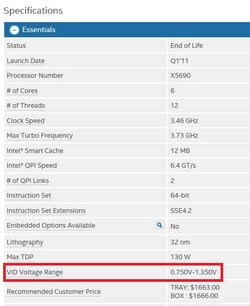Ok people, this is killing my OCD nature... 
VID = Voltage Identification (stock voltage)
Vcore = The voltage the CPU is currently using
Vcore can be VID, VID cannot be vcore unless the Vcore value is the same as the VID(stock voltage).
I have seen lately, over the past several months, people using VID as vcore. For example, I adjusted my VID to 1.35v. As I understand it, VID is the stock voltage of a given CPU. It is a STATIC VALUE on one chip but can be different on each chip as each chip's stock voltage is different.
To me though, VID cannot be the term used for anything outside of its stock voltage.So, when the heck did this change suddenly occur? I see this all over forums and am wondering if I missed the memo that VID is all of a sudden interchangeable with Vcore. Set me straight please or perhaps set those straight that are not using it right?



VID = Voltage Identification (stock voltage)
Vcore = The voltage the CPU is currently using
Vcore can be VID, VID cannot be vcore unless the Vcore value is the same as the VID(stock voltage).
I have seen lately, over the past several months, people using VID as vcore. For example, I adjusted my VID to 1.35v. As I understand it, VID is the stock voltage of a given CPU. It is a STATIC VALUE on one chip but can be different on each chip as each chip's stock voltage is different.
To me though, VID cannot be the term used for anything outside of its stock voltage.So, when the heck did this change suddenly occur? I see this all over forums and am wondering if I missed the memo that VID is all of a sudden interchangeable with Vcore. Set me straight please or perhaps set those straight that are not using it right?


